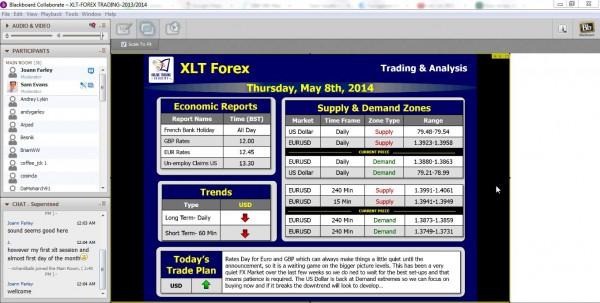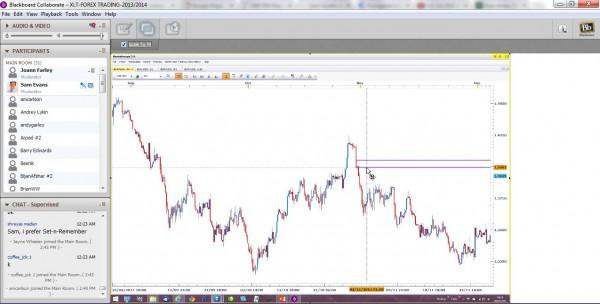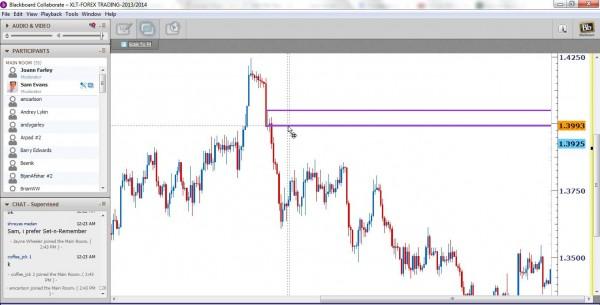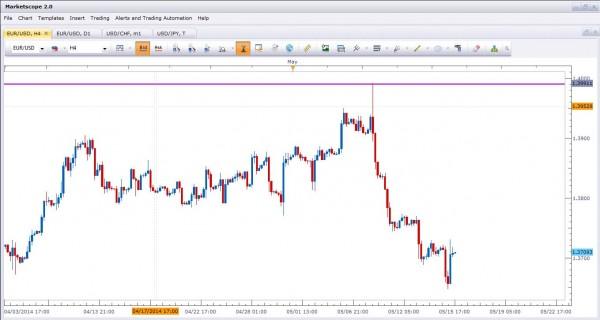![]()
Hello readers. I hope you have been having a great trading week so far. First, many thanks for your emails and comments on my last article about Candlestick patterns and charting. I am glad you found it useful! I promised at the end of that piece that I would be following up this week with a Part 2 to the article, however much like the markets change and we have to adapt, I have decided to postpone that offering for a few weeks as I believe this week’s topic relates to the current markets and would provide a useful lesson to learn.
As you will already know if you have been a regular reader of Lessons From the Pros over the years, I am purely a trader of Price Action, meaning, in its most simple terms, that I choose to make my trading and investing decisions on what the price is telling me and nothing more. Yes, I could look at the news and the fundamentals and of course I could also choose to employ the help of a few technical indicators as well but from experience I choose to focus my attentions on the things that the largest and most successful institutions do when they speculate in the FX markets, namely buying low and selling high.
The Online Trading Academy Core Strategy uses its rules-based logic to emulate the methods of how the banks do business in the financial markets, by recognizing the most important dynamic in the price discovery of anything which is pure Supply and Demand. If you know what you are looking for on a price chart and can also learn true objectivity so that you can trade only by what you see rather than what you think, you can also learn to get ahead of the game and develop a real edge in the FX markets. To be completely honest, if you trade without an edge you are never going to make it in this business and always be, as I call it, “late to the party.” What I mean by this it that conventional rules and theory behind trading tend to lag behind what is actually going on underneath the surface. Most struggling traders follow the usual opinion and analysis and see something happen which they did not plan for and they are left scratching their heads wondering why they didn’t see it coming.
If you find yourself in this predicament from time to time then fear not, it is common. Breathe a sigh of relief and understand that no trader out there really knows what is going to happen next but the most successful ones accept this, plan ahead of time and do their buying and selling based on logic and strict risk management rules to keep them in the game for the long term when they are wrong. The less you pay attention to what you think is happening and the more you focus on what you will do ahead of time, then the more you are likely to develop the all important edge. To illustrate this point let’s take a look at a recent XLT class I was teaching which shows this perfectly. Below we have a screenshot of a session in the Live Trading room and the prep-screen I put together before the session began:
In this shot we can see my analysis of the EURUSD currency pair and my Supply and Demand levels marked off ahead of time. The Supply zones are institutional areas where we wanted to sell the pair and the Demand levels are where we expect prices to rise, therefore providing a buying opportunity. Take a look at the 240 min Supply Zone between 1.3991 and 1.4061. It looked like this on the chart when I was demonstrating the level to the class in the live session:
As you can see from the chart above, the supply zones shows a huge imbalance between the buy and sell orders which resulted in price falling sharply from the area. Judging by the area I can safely say that it was probably major banks and institutions who were selling Euros here last time, so it would be pretty logical to say they may do the same again the next time prices are in the vicinity. Zoomed in a little more closely, the area looked like this:
When I teach an XLT and give out one of my trading ideas I like to show a zone in a generic style. Some students will use this as a guide and refine the entry to suit their own needs or maybe even tighten up the area so as to get a smaller risk and better reward. Either way, this area was a solid sell setup ahead of time and was easily set and forget, thus giving us the opportunity to be one of the very first to sell if prices reached our level. Interestingly enough, if you look to the first prep screen I showed you above, you will see that I had noted under the economic events calendar that ECB President Draghi was due to speak later that day and also that there would be a rate decision too. Anyone familiar with FX trading will know that rate decisions can be one of the most volatile market movers of all news events, so we should be aware of them.
However being aware is one thing but you also need to be prepared, as we were with our Supply Zone. Later that day, the ECB news came out and it was decided that rates on the Euro would be held at the same rate of 0.25% which was no big surprise. What was a surprise though was when Draghi followed this up with a comment that he and the ECB would be prepared to drop rates if they needed to in June. A drop in rates is very bearish for a currency and typically leads to devaluation in the currency itself. Draghi’s comments though were unexpected to many and very few people could have predicted that he would say this. Of course these comment led to a huge sell-off for the Euro. Ironically though, this sell-off was actually preceded by a sharp upwards spike in prices, right into our previously marked supply zone, as seen below:
Now of course there was no way for myself or the students to know that this would happen but we didn’t really care because we had out orders in place at the level well before the news and Draghi’s comments. All we knew was what an objective low risk, high reward trading opportunity looked like ahead of time and put our orders to sell EURUSD in the system when we knew what the plan was. Those who waited for the news and waited for the price would have found themselves trapped out by the initial spike in prices only to then have to chase a violent price reversal straight after. Who do you think took on more risk in this setup, the FX trader who followed the conventional methods or the one who followed the banks and institutions? I’ll let you decide but I think the answer is pretty obvious to us all. In trading things are mostly simple: buy it when it is low and sell it when it high. The best way to do this is when you listen to the only thing which gets you ahead of the rest and that is always the price itself.
Note: All information on this page is subject to change. The use of this website constitutes acceptance of our user agreement. Please read our privacy policy and legal disclaimer. Opinions expressed at FXstreet.com are those of the individual authors and do not necessarily represent the opinion of FXstreet.com or its management. Risk Disclosure: Trading foreign exchange on margin carries a high level of risk, and may not be suitable for all investors. The high degree of leverage can work against you as well as for you. Before deciding to invest in foreign exchange you should carefully consider your investment objectives, level of experience, and risk appetite. The possibility exists that you could sustain a loss of some or all of your initial investment and therefore you should not invest money that you cannot afford to lose. You should be aware of all the risks associated with foreign exchange trading, and seek advice from an independent financial advisor if you have any doubts.
Editors’ Picks
EUR/USD fluctuates in daily range above 1.0600

EUR/USD struggles to gather directional momentum and continues to fluctuate above 1.0600 on Tuesday. The modest improvement seen in risk mood limits the US Dollar's gains as investors await Fed Chairman Jerome Powell's speech.
GBP/USD stabilizes near 1.2450 ahead of Powell speech

GBP/USD holds steady at around 1.2450 after recovering from the multi-month low it touched near 1.2400 in the European morning. The USD struggles to gather strength after disappointing housing data. Market focus shifts to Fed Chairman Powell's appearance.
Gold aiming to re-conquer the $2,400 level

Gold stages a correction on Tuesday and fluctuates in negative territory near $2,370 following Monday's upsurge. The benchmark 10-year US Treasury bond yield continues to push higher above 4.6% and makes it difficult for XAU/USD to gain traction.
XRP struggles below $0.50 resistance as SEC vs. Ripple lawsuit likely to enter final pretrial conference

XRP is struggling with resistance at $0.50 as Ripple and the US Securities and Exchange Commission (SEC) are gearing up for the final pretrial conference on Tuesday at a New York court.
US outperformance continues

The economic divergence between the US and the rest of the world has become increasingly pronounced. The latest US inflation prints highlight that underlying inflation pressures seemingly remain stickier than in most other parts of the world.
RECOMMENDED LESSONS
Making money in forex is easy if you know how the bankers trade!
Discover how to make money in forex is easy if you know how the bankers trade!
5 Forex News Events You Need To Know
In the fast moving world of currency markets, it is extremely important for new traders to know the list of important forex news...
Top 10 Chart Patterns Every Trader Should Know
Chart patterns are one of the most effective trading tools for a trader. They are pure price-action, and form on the basis of underlying buying and...
7 Ways to Avoid Forex Scams
The forex industry is recently seeing more and more scams. Here are 7 ways to avoid losing your money in such scams: Forex scams are becoming frequent. Michael Greenberg reports on luxurious expenses, including a submarine bought from the money taken from forex traders. Here’s another report of a forex fraud. So, how can we avoid falling in such forex scams?
What Are the 10 Fatal Mistakes Traders Make
Trading is exciting. Trading is hard. Trading is extremely hard. Some say that it takes more than 10,000 hours to master. Others believe that trading is the way to quick riches. They might be both wrong. What is important to know that no matter how experienced you are, mistakes will be part of the trading process.




